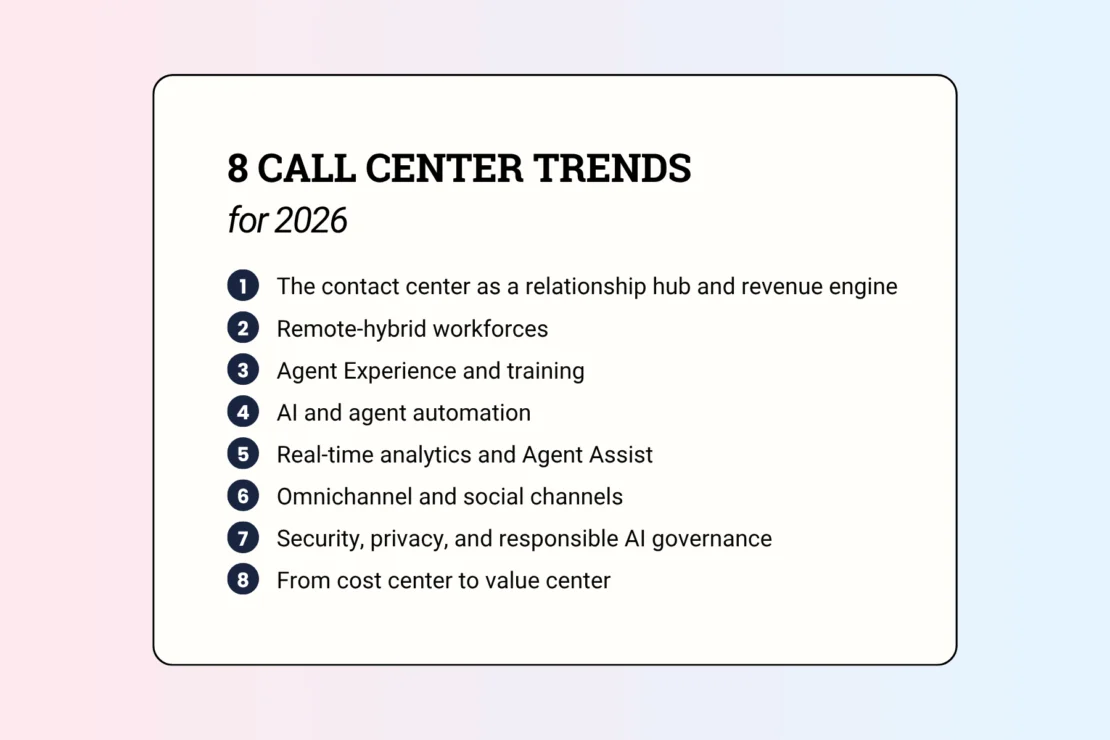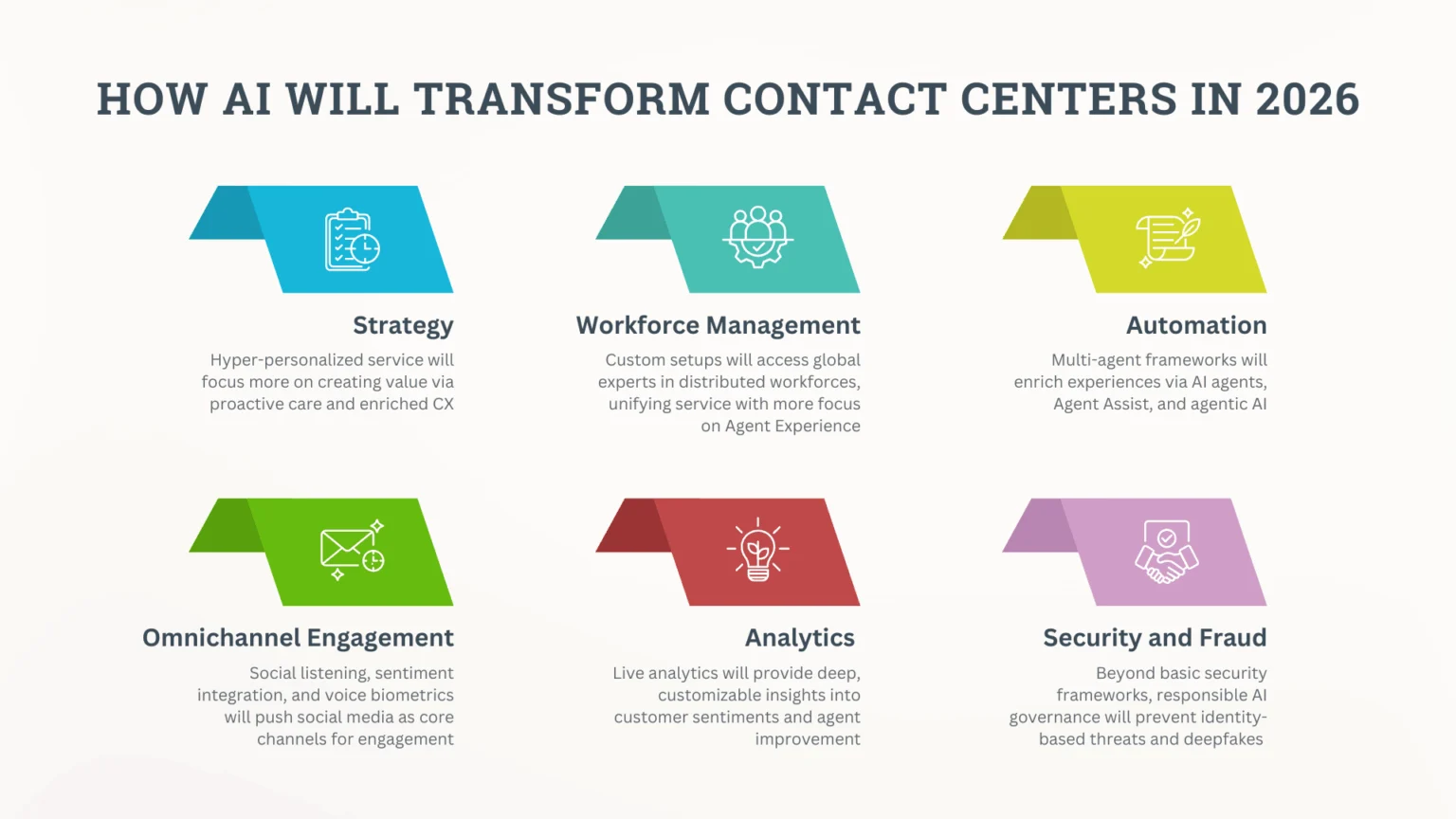Read Time: 10 minutes
Table of Contents
Introduction
Innovation is constantly revolutionizing our world, from technology to business practices, customer behaviors, and support strategies. The need for service teams not only to be on high alert but also to up their game has never been higher. Keeping up with the latest trends in customer support best practices and innovative technologies will ensure your team accurately predicts and answers customer needs, pushing your organization ahead of the competition and ensuring your long-term success.
Capture and act on your growth potential by establishing a call center that always looks toward the future. Visionary tactics predict upcoming trends, helping you target them with efficiency and effectiveness — and maybe even set some of your own for truly exceptional, results-driven service.
Our article covers these key trends transforming contact centers in 2026:
- The contact center as a relationship hub and revenue engine
- Remote workforces
- Agent Experience and training
- AI and agent automation
- Real-time analytics and Agent Assist
- Omnichannel and social channels
- Security, privacy, and responsible AI governance
- From cost center to value center
Key takeaways
- The contact center is evolving into a strategic value and revenue hub. By 2026, leading organizations will treat their contact centers as value centers, blending human empathy with AI to drive customer trust, satisfaction, and long-term loyalty.
- AI and advanced technologies will power hyper-personalized, proactive support through tools such as AI agents, voice analytics, predictive sentiment analysis, and omnichannel integrations.
- Agent Experience, remote work, and responsible AI are essential for scalable success. Remote, distributed teams and cloud-based systems will continue to replace traditional mega-centers. Security, privacy, and ethical AI governance are paramount to maintaining customer trust in a high-tech, hyper-connected world.

The contact center as a relationship hub and revenue engine
Long gone are the days when call centers existed solely to answer phones with reactionary solutions. Your support team is crucial to your company, the face (or the voice) that tells your customers who you really are. As such, building meaningful relationships is key to humanizing support, achieving or surpassing goals, and generating revenue.
Transform your strategies from reactionary to proactive with these solutions that build relationships and revenue.
Hyper-personalization
Customers are already expecting personalized support in every interaction. In a world where algorithms tailor experiences using historical and live data, we have more access to more vast, diverse, and nuanced data than ever before.
In 2026, use these data analytics to understand customer preferences, behavior, and pain points to enrich every stage of the customer journey.
Voice and speech intelligence
In addition to browsing data and purchase history, your support tools can tell you a lot about customer needs. Sentiment, emotion, and tone analytics technologies track changes in how your customer feels throughout an interaction, giving you detailed insight into the effectiveness of each solution, for each customer.
In 2026, use voice and speech intelligence to understand and accurately serve continuously evolving customer sentiments.
Proactive customer engagement
Proactive support is a mindset and a strategy that should inform your entire support model. It allows you not only to stay ahead of potential issues but also to foster trust with customers via seamless, supportive experiences.
It’s also better for business than reactive support is. In 2026, use these proactive support tools to streamline experiences while making significant waves in operational efficiency:
- Advanced technology stack tracks cross-channel data in a unified platform.
- Customer journey mapping enriches end-to-end experiences.
- Chatbots and automations unify experiences and provide immediate support.
- Self-service tools such as FAQs, guides, and knowledge bases reduce the amount of inquiries your team sees.
- Predictive and sentiment analytics identify trends and tailor solutions to each customer.
- Specialized training empowers agents with anticipatory communication skills.
- Agent matching aligns customers with agents according to skill, preference, availability, and need.
Value center
As powerful as technology is for streamlining experiences, live human connection also is vital for helping customers feel heard and emotionally supported. Follow these steps in 2026 to transition from a call center to a value center that builds relationships and revenue.
- Enriched community spaces and empathetic support teams build relationships with customers.
- Invest in brand immersion techniques to enhance outsourced agent confidence and proficiency to further foster trust and engagement.
- Leverage artificial intelligence and human emotional intelligence to provide a comprehensive, efficient experience that builds connections and boosts customer satisfaction, engagement, and retention.
Want to scale your business?
Global Response has a long track record of success in outsourcing customer service and call center operations. See what our team can do for you!
Remote workforces
Work-from-home solutions have always maximized productivity and employee satisfaction, but the COVID-19 pandemic drove home just how effective remote work could be for businesses. While many industries have gone back to the office, remote contact centers are a major tenet of scalable business process optimization through outsourced teams.
In 2026, we anticipate that mega centers might be fading as workforce models continue to evolve. Companies are turning more heavily to outsourcing for increased efficiency, cost-effectiveness, and customizable, scalable solutions.
These tools will help companies achieve peak flexibility in staffing and managing remote teams:
- Distributed workforces across multiple locations to leverage a global agent pool
- Cloud-based contact centers for seamless integrations and global connectivity
- Autonomous routing via smarter, more adaptive IVRs for efficient call distribution and queue management
- Agent copilots for elevated service quality and consistency
- Agent Experience (AX) as a strategic priority for reduced attrition and better performance
Agent Experience and training
Efficiency is the key to business and customer success, but high-quality results are impossible to achieve without the dedicated efforts of your team. Empower agents to elevate service quality by enriching agent experiences and investing in agent success.
Start by re-thinking your training for the evolving call center industry. Effective training currently uses and in 2026 will use these tactics with enhanced data and ever-improving tools to improve agent confidence, speed-to-proficiency, satisfaction, performance, and retention.
- Re-imagined training programs leverage AI to preserve group knowledge while streamlining training and onboarding times.
- Asynchronous learning allows agents to learn on their own time without the guidance of in-person instructors.
- Gamified, AI-driven training simulates real scenarios for hands-on, stress-free learning.
- Continuous agent training improves performance via live AI assistants during interactions and automated summaries, notes, analytics, and tips following interactions.
- Synthetic data training mimics patterns and features of real data, improving AI performance even in cases with scarce data or strict security regulations.
- Augmented data training modifies existing datasets, exposing models to diverse input patterns to improve performance without extensive data collection.
AI and agent automation
In the age of intuitive CX, artificial intelligence is key to unlocking insights that will help you serve customers at greater capacity and greater efficiency than ever before. As personalized services engage customers in more nuanced and human-like ways in 2026 through AI, automation will grow in popularity, type, and function beyond the now-familiar chatbots.
We anticipate certain changes in the following automated technologies that will streamline experiences and personalize service at scale for more high-powered and intelligent support in 2026.
- AI agents: In 2026, Agentic AI will move from experimentation stages to real-world application. Companies will integrate agentic AI into users’ daily lives across apps, achieving goals and completing complex tasks at scale.
- Conversational AI and chatbots: Personalized assistants will make AI more invisible to users as they understand and replicate human language with more contextual understanding and nuance.
- AI-first voice agents: Real-time, human-like AI voice agents will automate interactions across voice channels, significantly reducing wait times and improving experiences. They will autonomously perceive and process natural language to naturally interact with customers.
- Deeper capabilities via real-time conversational automation: Autonomous agents will complete account-level actions, using AI technologies to process queries, simulate human conversations, and retrieve live customer data.
- Multi-agent AI frameworks: Multiple autonomous AI agents combine text, voice, and vision capabilities to work together to complete tasks across channels, accomplishing much more than just one bot can.
- Human and AI collaboration: As sophisticated as these AI models are, companies will still rely on human agents for interactions requiring live support, for investigating potential issues, and refining AI training datasets.

Real-time analytics and Agent Assist
Live assistance for agents and customers is vital for high-quality service delivery and CX engagement. In 2026, live AI will be better than ever as platforms have trained on diverse, constantly evolving datasets to learn all the ins and outs of company policy.
Agents and customers will rely on real-time tips and guidance to resolve issues, improve performance, and resolve their own questions, minimizing escalations, transfers, holds, and wait times and improving retention.
These main tenets of real-time assistance will prove vital for the performance of contact center agents in 2026:
Advanced analytics will provide deep, customizable insights into trends and potential issues, enabling the automation of proactive support.
Real-time conversational analytics will help organizations gain visibility into evolving customer sentiments across channels.
Live prompts will help agents find answers to questions, improving first-call resolution rates and handling time.
Compliance flagging tools will handle escalations with more sophistication and nuance as they alert teams to potential issues, helping agents reduce errors in real time. This must-watch sub-trend is vital for ensuring secure long-term operational efficiency.
Real-time Agent Assist will work together with live agents to boost service quality through tips and insights gained from customer sentiment tracking, customer history, and data analytics.
Omnichannel and social channels
As customers and organizations embrace virtual engagement across the customer journey, messaging and social media support are moving from second-class channels to core channels. Text and social platforms are prime places for customers to voice their opinions, engage in communities, and find solutions to their problems at their convenience. The boom in interactions allows organizations to gain more comprehensive data, prompting them to engage in key strategies breaking through the support industry in 2026:
- Omnichannel integration allows organizations to track, handle, and analyze vast amounts of sentiments across social media and messaging platforms. Large amounts of customer service interactions are happening over social media, and secure integration makes handling it in one place seamless.
- Social listening enables brands to track conversations and mentions about any topic, from mentions of their brand to specific insights about products or services.
- Sentiment integration is becoming a key aspect of support operations, prioritizing customer experience. It enables teams to enrich all touchpoints of the customer journey based on comprehensive feedback.
- Voice biometrics use unique vocal attributes such as pitch, accent, speed of speech, cadence, and tone, as well as physiological factors like the shape and size of a speaker’s mouth and throat, to create a distinctive voiceprint that verifies users and customers and prevents fraud.
- Seamless integrations in advanced technology facilitate smooth handoffs from inbound to digital channels for a support strategy that meets customers where they are.
Security, privacy, and responsible AI governance
Generic data security isn’t going to cut it in 2026. Fraud prevention and responsible AI governance require more sophisticated, aggressive strategies than ever before as attackers leverage innovations in technology to target customers and brands with alarming precision and stealth. The constantly evolving, ever-improving nature of AI makes it a tool for good as much as a liability if used with ill or malintent.
Leaders in technology and customer support prioritize responsible AI governance with key strategies:
- Building trust in voice channels: Implementing voice biometrics to detect and prevent voice spoofing and voice cloning.
- Detecting and preventing deepfakes: Using advanced technology to detect deepfakes and synthetic voices in real time and pre-answer technology to assess risks before deepfakes are attempted.
- Implementing zero-trust architectures: Addressing the complexities of digital threats by never trusting, always explicitly verifying access based on multiple data points.
- Preventing identity-based threats: Bolstering identity fraud prevention by unifying identity management systems, setting up robust security frameworks, and preparing for regular audits.
From cost center to value center
As AI is incorporated into all aspects of consumers’ daily life and business practices, engagement is blossoming. Teams are prepared to boost operational efficiency and customer experience with more personalized, automated support than ever before. This transforms contact centers from a necessary cost-incurring reactive strategy to a value-building long-term asset that enables you to cultivate trust and dynamic relationships at scale.
But with the innovations in technologies and CX improvement comes the emerging importance of reducing harm, improving trust metrics, and effectively mitigating complaints. The focus is no longer just on reducing costs or maximizing efficiency.
Your eye should be on continuously establishing your business as a value-generating source for customers. Value sets your company apart, earns trust, and brings a return on investment that will prove invaluable as trends in technology and strategies continue to change.
Ready to start generating value for your customers? Contact Global Response to see how we can leverage 2026 call center trends for your business today.




